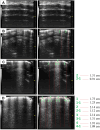Application of ultrasound in assessment of acute lung injury in mice
- PMID: 41056309
- PMCID: PMC12503332
- DOI: 10.1371/journal.pone.0332912
Application of ultrasound in assessment of acute lung injury in mice
Abstract
This study evaluated the effectiveness of non-invasive ultrasound technology in monitoring pulmonary edema in a mouse model of acute lung injury (ALI). Male C57BL/6J mice were instilled through the trachea with lipopolysaccharide (LPS, 5 mg/kg, single dose) to induce ALI. The change in B-lines (an ultrasound sign) were monitored using the Vevo 3100 system and the lung ultrasound (LUS) score was generated to quantify the severity of edema, meanwhile lung function was assessed by whole-body plethysmography (WBP) and the progression of ALI was tracked by lung weight and histopathological analysis. LUS detection revealed that non-converging B-lines appeared on the first day, followed by an increase in the number of B-lines that began to converge, peaking on the day-3 and then the number of B-lines decreased, almost disappearing by the 11 days after LPS intervention. Significant changes in lung functional parameters were recorded during 6-24 h with most parameters returning to baseline levels at day-3. Morphological and weight assessments of the lung showed that most severe lung congestion and increased weight at day-3 and returning to normal by 11 days. Histopathological examination unveiled that LPS-induced inflammation was characterized by increased cellular infiltration, thickening of alveolar septa, vascular congestion, and atelectasis, which were most severe on days 3-5 and then gradually improved. A positive correlation between LUS score and the lung injury index (r = 0.783, P < 0.001) or the lung weight-to-tibial length ratio (r = 0.695, P < 0.001) was observed, reflecting a sensitivity of LUS to the severity of edema. In addition, at 24 h following LPS intervention, the LUS score was also positively or negatively correlated with a series of lung functional indices. In conclusion, the study demonstrated that LUS is an effective, reliable and non-invasive tool for monitoring pulmonary edema in a mouse model of ALI. The significant correlations between LUS scores with various pathophysiological parameters, highlight its potential in assessing the severity of ALI in mice.
Copyright: © 2025 Deng et al. This is an open access article distributed under the terms of the Creative Commons Attribution License, which permits unrestricted use, distribution, and reproduction in any medium, provided the original author and source are credited.
Conflict of interest statement
The authors have declared that no competing interests exist.
Figures







References
-
- Imam F, Al-Harbi NO, Al-Harbi MM, Ansari MA, Zoheir KMA, Iqbal M, et al. Diosmin downregulates the expression of T cell receptors, pro-inflammatory cytokines and NF-κB activation against LPS-induced acute lung injury in mice. Pharmacol Res. 2015;102:1–11. doi: 10.1016/j.phrs.2015.09.001 - DOI - PubMed
MeSH terms
Substances
LinkOut - more resources
Full Text Sources

